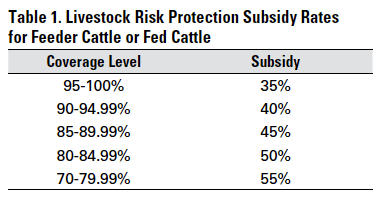Bagley Risk Management : Safeguarding Your Organization Future
Bagley Risk Management : Safeguarding Your Organization Future
Blog Article
Recognizing Animals Risk Protection (LRP) Insurance Policy: A Comprehensive Overview
Browsing the world of livestock risk protection (LRP) insurance coverage can be a complicated venture for lots of in the agricultural field. This kind of insurance coverage offers a safeguard against market changes and unpredicted circumstances that could influence livestock producers. By understanding the ins and outs of LRP insurance, producers can make enlightened decisions that might safeguard their operations from economic risks. From exactly how LRP insurance policy functions to the various insurance coverage choices readily available, there is much to uncover in this extensive overview that might possibly shape the means animals manufacturers come close to risk management in their services.

Exactly How LRP Insurance Policy Functions
Periodically, understanding the mechanics of Animals Risk Defense (LRP) insurance policy can be intricate, yet breaking down exactly how it functions can provide clearness for herdsmans and farmers. LRP insurance policy is a danger monitoring tool created to shield animals producers against unexpected rate decreases. The plan allows manufacturers to establish an insurance coverage degree based on their details demands, selecting the number of head, weight range, and coverage price. As soon as the policy remains in place, if market value drop listed below the coverage rate, manufacturers can sue for the difference. It is necessary to keep in mind that LRP insurance is not a profits warranty; instead, it focuses solely on cost danger security. The insurance coverage period commonly varies from 13 to 52 weeks, providing versatility for producers to choose a period that lines up with their manufacturing cycle. By utilizing LRP insurance coverage, ranchers and farmers can mitigate the economic threats related to varying market value, guaranteeing better security in their operations.
Qualification and Insurance Coverage Options

When it comes to insurance coverage options, LRP insurance supplies manufacturers the adaptability to pick the protection degree, protection period, and endorsements that best suit their threat monitoring needs. By understanding the eligibility standards and insurance coverage alternatives offered, livestock manufacturers can make enlightened choices to handle risk effectively.
Benefits And Drawbacks of LRP Insurance Policy
When evaluating Animals Risk Security (LRP) insurance, it is important for animals manufacturers to consider the advantages and drawbacks inherent in this threat administration tool.

One of the key benefits of LRP insurance is its capability to give protection versus a decrease in animals rates. Additionally, LRP insurance policy supplies a degree of flexibility, enabling manufacturers to personalize insurance coverage degrees and plan periods to fit their particular demands.
Nevertheless, there are likewise some downsides to take into consideration. One constraint of LRP insurance is that it does not safeguard versus all kinds of risks, such as disease outbreaks or all-natural calamities. In addition, premiums can sometimes be pricey, particularly for producers with large animals herds. It is vital for manufacturers to carefully assess their specific danger exposure and financial scenario to establish if LRP insurance coverage is the appropriate threat monitoring tool for their procedure.
Understanding LRP Insurance Coverage Premiums

Tips for Maximizing LRP Perks
Maximizing the advantages of go to the website Animals Threat Defense (LRP) insurance coverage needs calculated preparation and positive threat management - Bagley Risk Management. To make the most of your LRP insurance coverage, consider the following suggestions:
Consistently Assess Market Conditions: Remain notified concerning market fads and price fluctuations in the livestock market. By checking these variables, you can make enlightened decisions about when to purchase LRP coverage to protect against potential losses.
Set Realistic Coverage Levels: When picking coverage levels, consider your production prices, market worth of animals, and possible risks - Bagley Risk Management. Setting go to this web-site reasonable protection degrees makes certain that you are effectively shielded without paying too much for unneeded insurance coverage
Diversify Your Insurance Coverage: Rather than counting exclusively on LRP insurance, consider expanding your danger management approaches. Incorporating LRP with other risk administration devices such as futures agreements or choices can offer extensive coverage versus market uncertainties.
Evaluation and Change Coverage Regularly: As market problems transform, regularly review your LRP insurance coverage to guarantee it lines up with your current threat exposure. Changing coverage levels and timing of acquisitions can aid maximize your risk defense technique. By complying with these suggestions, you can optimize the benefits of LRP insurance coverage and protect your animals operation versus unforeseen risks.
Conclusion
Finally, animals threat defense (LRP) insurance policy is a valuable device for farmers to manage the economic risks related to their livestock procedures. By understanding exactly how LRP functions, eligibility and protection alternatives, as well as the pros and disadvantages of this insurance coverage, farmers can make informed decisions to secure their livelihoods. By very carefully considering LRP premiums and carrying out techniques to make the most of benefits, farmers can alleviate possible losses and ensure the sustainability of their procedures.
Animals producers interested in getting Livestock Threat Defense (LRP) insurance coverage can explore a range of eligibility criteria and insurance coverage choices tailored to their specific livestock operations.When it comes to coverage options, LRP insurance provides producers the adaptability to choose the insurance coverage degree, protection period, and recommendations that ideal suit their threat administration requirements.To realize the intricacies of Livestock Risk Defense (LRP) insurance coverage completely, recognizing the variables affecting LRP insurance policy costs is important. LRP insurance coverage costs are figured out by numerous components, including the insurance coverage degree chosen, the expected price of livestock at the end of the coverage period, the type of livestock being guaranteed, and the length of the insurance coverage period.Review and Readjust Insurance Coverage Routinely: As market problems alter, i was reading this occasionally assess your LRP coverage to guarantee it straightens with your existing threat direct exposure.
Report this page